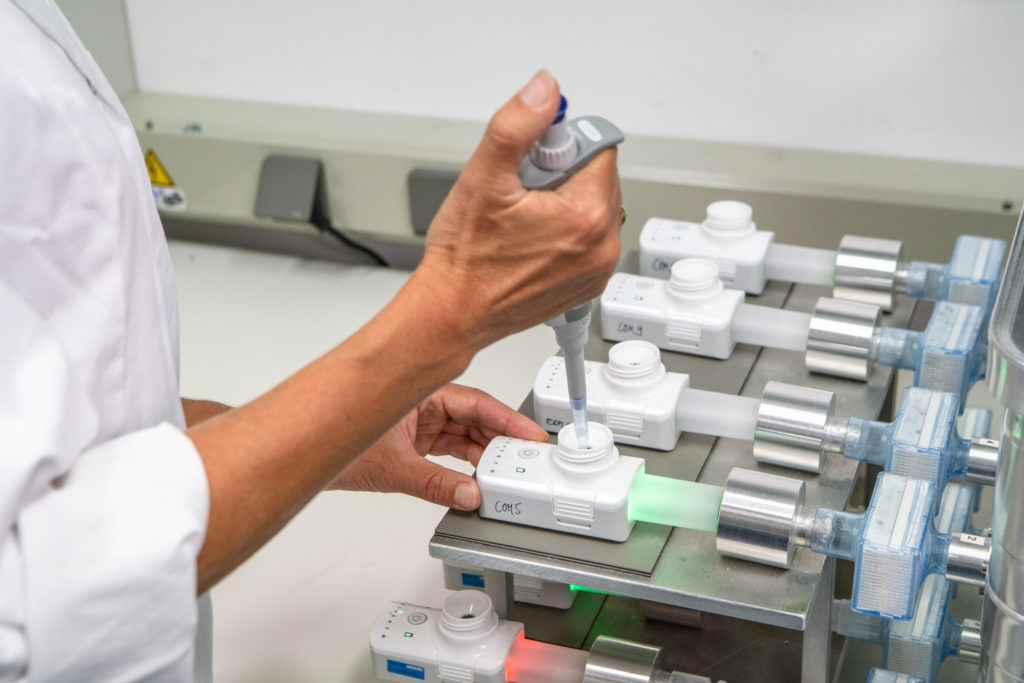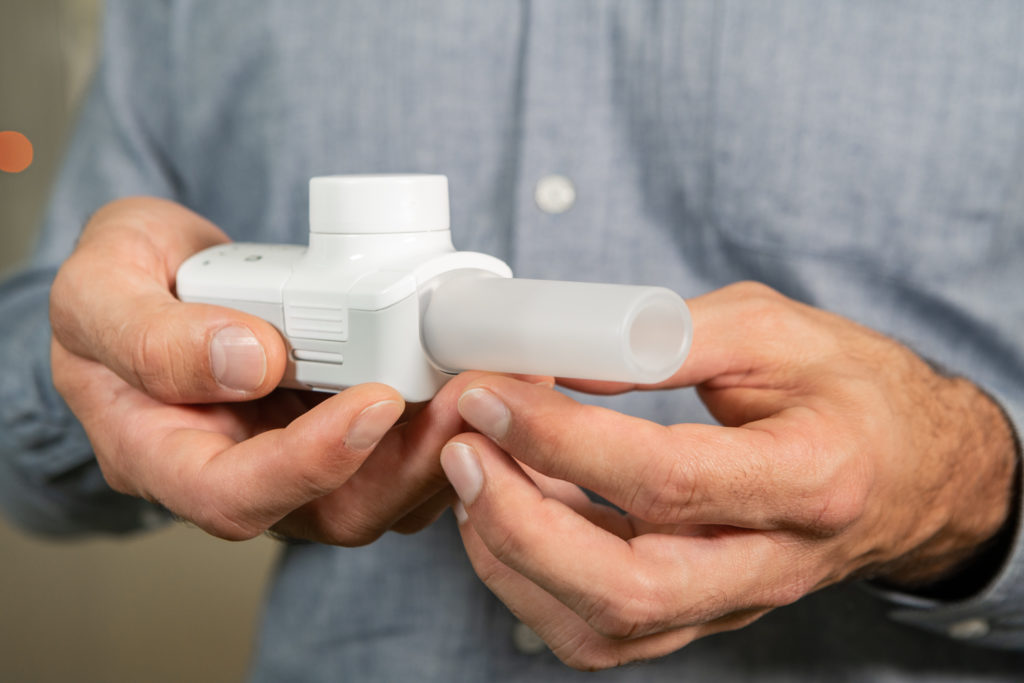To Issue 131
Citation: Lock D, “Evolution of Nebulisation for Drug Delivery to the Lungs”. ONdrugDelivery, Issue 131 (Apr 2022), pp 58–60.
Daniel Lock discusses the latest innovations in nebuliser technology for drug delivery to the lungs.
The term “nebuliser” represents a diverse and differentiated group of devices that deliver inhaled therapeutics to the lungs, encompassing jet nebulisers, ultrasonic nebulisers and, more recently, innovative vibrating-mesh nebuliser devices. The array of nebuliser devices now available is as diverse as the full range of delivery options available to innovators in the inhaled pharmaceutical sector, including pressurised metered dose inhalers (pMDIs), dry powder inhalers (DPIs) and soft mist inhalers (SMIs). To assume that all the nebuliser devices currently available offer the same benefits could be restrictive in terms of getting an inhaled pharmaceutical product to market.
“The long treatment times associated with nebulisers have been dramatically reduced by advances in device technology, paving the way for their use in a wider variety of product concepts.”
Traditionally, nebulisers may have been viewed as the lesser-used, older-generation devices when compared with smaller, more scalable pMDIs and DPIs. However, there are some circumstances in which nebulisers are particularly suitable, such as helping the very young, infirm or physically or cognitively impaired to manage their respiratory conditions. For patients who are barely conscious or mechanically ventilated, a low-velocity aerosol with a particle-size distribution suitable for inhalation is ideal for administration without the need for active patient participation.
Nebulisers also provide emergency care for severe asthma attacks, exacerbations due to lung disease and serious inspiratory effects of viral infections, such as those witnessed during the covid-19 pandemic, as well as being able to deliver high doses of medication over extended treatment times. Additionally, where a drug cannot be delivered by DPI or pMDI due to it not being available in those dosage forms – including off-label use or because of a high total drug delivery requirement, such as might be the case with antibiotics and biologics – a nebuliser may be a highly effective alternative administration device (Figure 1).

Figure 1: Testing nebuliser devices.
Furthermore, formulating a drug in a liquid preparation is often more straightforward in terms of costs and managing the stability of the API, while different fill volumes and/or concentrations make dose escalation and dose range finding simpler at an early stage.
Driven by advances in technology, innovations in inhaled therapeutics and covid-19, the profile of nebuliser users is changing and expanding. Nebulisers are now increasingly being considered for delivery of high-value, narrow therapeutic index medicaments; the management of lung disease for patients on the move; and delivery of specialised respiratory products not historically delivered using nebulisers, such as systemic or “off-target” delivery, cytokine and hormone therapies.
Nebulisation is not usually associated with precision. However, advances in technology have driven increased reproducibility for drug-nebuliser combination products. Similarly, the long treatment times associated with nebulisers have been dramatically reduced by advances in device technology, paving the way for their use in a wider variety of product concepts. They are evolving from simpler, air-driven devices to ultrasonic atomisers and, most recently, vibrating mesh nebulisers (Figure 2), becoming smarter, quieter, more portable and more efficient.

Figure 2: A handheld vibrating mesh device, which delivers nebulised drug products deep into the lungs.
Air-driven jet nebulisers have traditionally dominated the market but innovators are increasingly focusing on vibrating mesh devices, which offer a low-velocity, actively produced aerosol. Unlike most DPIs, which are passive and high velocity – or pDMIs, which are active and high velocity – a mesh nebuliser has the ability to achieve precise control over when the formulation is aerosolised and for how long, and can also be tailored to the properties of the formulation being nebulised.
There are several successful vibrating mesh nebulisers on the market. These include devices that produce a continuous aerosol for tidally breathing patients – normal breathing at rest – and ones that incorporate sophisticated features, such as monitoring the breathing behaviour of the patient to time the bolus, thereby optimising drug delivery to the lungs and reducing waste to the environment. These types of devices can also include other advanced features, such as visual displays and automatic empty detection.
“The selection and design of the most appropriate nebuliser device depends on a number of factors, including the intended location of treatment, the severity of disease and the target patient population.”
The selection and design of the most appropriate nebuliser device depends on a number of factors, including the intended location of treatment, the severity of disease (relief of acute, life-threatening symptoms or management of a chronic condition) and the target patient population. Their use and nature can be diverse – compare an inline, continuously producing nebuliser device used for a patient attached to a ventilator with, at the other end of the spectrum, a small handheld device that provides audible and visual feedback and directs the patient to breathe in a particular manner. Both of these devices are considered nebulisers but fulfil very different roles. In the case of the inline, continuously producing nebuliser, its size and design is secondary compared with the specific patient need.
Likewise, if a patient is admitted to hospital gasping for breath and in a state of confusion, a device that requires precise co-ordination to operate could be dangerously inadequate – even if, in other circumstances, it would provide very high and effective doses to the lungs. On the other hand, such a precise and accurate device could be very well suited for the delivery of higher-cost, narrow therapeutic index medicaments in the domiciliary setting.
The use of functional respiratory imaging using high-resolution computed tomography (CT) scans and computational fluid dynamics has demonstrated that, by using a device that carefully controlled flow and volume, the lung deposition of idiopathic pulmonary fibrosis patients was approximately two-and-a-half times greater than with a continuously operating system used with tidal breathing.1 Furthermore, the increase in the deep lung deposition achieved was of even greater magnitude.
The advent of “smart” nebuliser technology was instigated, in part, by the fact that nebulisers already had requirements for a power source and, later, battery power sources and circuit boards suitable for more advanced controls. In addition, device developers responded to market trends calling for greater patient compliance in clinical trials and for commercialised home-use products with an array of features and companion apps for connected devices. This created conditions for the development of more sophisticated drug delivery devices.
Vibrating-mesh nebulisers, for example, have been designed to “coach” the patient to inhale in a manner that can maximise lung deposition, especially in the deep lung. Particle size of the inhaled formulation is an important parameter for successful pulmonary delivery. However, it is not the only factor and can be less important if, for example, the patient’s inhalation is too shallow or too rapid. A well-controlled particle size distribution, a low-velocity aerosol and carefully guiding and training the patient have been shown to achieve extremely high lung doses, such that even particles larger than the typically accepted cut-off of 5 μm may reach the deeper regions of the lung.
“The development of smart nebuliser devices offers the opportunity to expand their use to wider patient groups, rather than simply for those who cannot use a pMDI or DPI effectively.”
The manner in which patients can be influenced to use a device varies but is governed by what is reasonable and, ultimately, what can be proven in well designed human factors studies. For example, using a combination of soft control features, such as coloured lights and barometric or haptic feedback, can result in a high level of accuracy and reproducibility, allowing optimal deposition to become simple and intuitive. Devices can be designed to be breath actuated – they will not nebulise unless a pressure drop is detected and, if the patient stops inhaling midway through the breath pattern or exceeds the intended inhalation volume, they can be alerted by a sharp increase in device resistance, as well as audible and visible cues.
The development of smart nebuliser devices offers the opportunity to expand their use to wider patient groups, rather than simply for those who cannot use a pMDI or DPI effectively. Additionally, nebulisers will no longer be restricted to emergency respiratory care but will become real options for the delivery of cutting-edge, high-cost, high-tech or systemically acting treatments thanks to their increasingly efficient and precise delivery to the lung.
Device technology advancements are outpacing the clinical and commercial elements that determine their use but the increasing array of device features and associated connectivity presents some very interesting possibilities for the future. With increased control over the flow rate and inhalation volume, interpatient variance – at least in terms of regional deposition and topical exposure to drug product – could be significantly reduced.
The benefits of controlled breathing patterns already demonstrate a predicted reduction in total lung dose variability, which potentially could be taken a step further by using spirometry data to normalise for individual lung function – in essence, normalising for inspiratory capacity. The extent to which this is sensible is multivariate but there is no doubt that these features provide significant potential benefits for clinical development, whether or not the final device is a nebuliser product. Furthermore, as nebulisers are more frequently used in the domiciliary setting, this creates new and interesting areas for innovation to make their use, cleaning and maintenance more straightforward, with the ultimate goal of improving patient compliance.
Nebulisers are already attractive devices to obtain early-phase clinical data for new chemical entities. Couple this with connected health to collect important metadata and the potential to de-risk clinical trials by removing some of the inherent variability, and smart nebulisers offer the opportunity to significantly accelerate development and the understanding of products under development.
Traditional nebulisers will still be used and will continue to meet an important need. However, if the goal is to deliver high-cost speciality drug products precisely and efficiently, a smart nebuliser may offer the technology that can achieve this.
REFERENCE
- Munro S et al, “Matching delivery device to a patient’s condition: Use of lung deposition modelling to optimise delivery in idiopathic pulmonary fibrosis”. Drug Delivery to the Lungs Conference (DDL2017), Edinburgh, UK, Dec 6–8, 2017.

